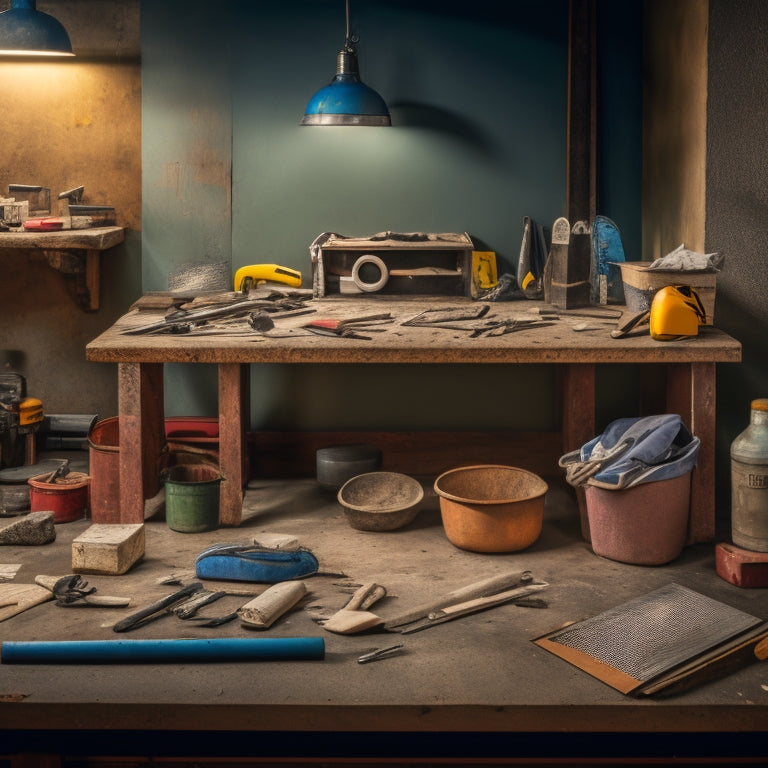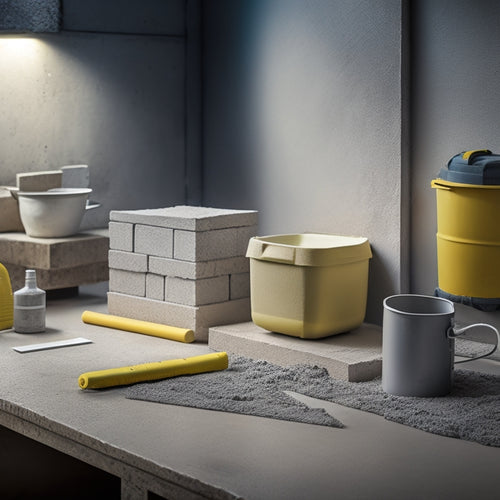
3 Best Hand Tools for Concrete Wall Construction
Share
When constructing a concrete wall, you'll need three essential hand tools to guarantee a successful project. A reliable tamping tool is first, as it compacts and levels freshly poured concrete, removing air pockets and excess water for even distribution. Next, a versatile cutting tool is necessary for making precise cuts, with diamond-coated or carbide-tipped blades ideal for different tasks. Finally, a smoothing finishing tool is vital for achieving a uniform finish, with options like trowels, edgers, and floats available for specific applications. By mastering these tools, you'll be well on your way to achieving a professional-looking concrete wall.
Key Takeaways
• Smoothing trowels are essential for removing air pockets and excess material in concrete wall construction.
• Surface edgers create clean, defined edges along the concrete wall perimeter, ensuring a professional finish.
• Floats are used to eliminate imperfections and ensure a uniform finish, available in various sizes and shapes for different applications.
• High-quality finishing hand tools are necessary to achieve a smooth, even finish in concrete wall construction.
• Tamping tools are crucial for compacting and leveling freshly poured concrete, removing air pockets and excess water for even distribution.
Essential Tamping Tool Options
When constructing a concrete wall, you'll need to compact and level the freshly poured concrete, and that's where vital tamping tool options come into play. To achieve a smooth, even finish, you'll need to master various tamping techniques. This includes using a tamper to remove air pockets, excess water, and to evenly distribute the concrete's aggregate. You'll also need to employ the right amount of pressure to avoid over- or under-compacting the concrete.
To guarantee your tamping tools remain in top condition, regular tool maintenance is essential. Clean your tamper after each use, removing any dried concrete or debris. Apply a rust-inhibiting coating to metal components to prevent corrosion. Additionally, inspect your tamper's handle for signs of wear, replacing it if necessary.
Must-Have Cutting Tools
As you progress toward the next stage of concrete wall construction, you'll need to equip yourself with must-have cutting tools to accurately cut and shape the concrete to your specifications.
When it comes to saws, you'll want to have a variety of types at your disposal, including circular saws, reciprocating saws, and masonry saws. Each saw type is designed for specific cutting tasks, so it's vital to choose the right one for the job.
The blade material is also a critical factor to evaluate. Diamond-coated blades are ideal for cutting through concrete, as they provide a clean cut and minimize dust production. Carbide-tipped blades, on the other hand, are better suited for cutting through rebar and other metal reinforcements.
Additionally, think about investing in a concrete saw with a built-in dust suppression system to improve visibility and reduce cleanup time.
With the right cutting tools, you'll be able to make precise cuts and achieve a high-quality finish in your concrete wall construction project.
Finishing Touch Hand Tools
With the concrete wall structure taking shape, you'll need to turn your attention to the finer details, equipping yourself with finishing touch hand tools that will help you achieve a smooth, even finish.
These tools are essential for creating a professional-looking finish that will impress clients and set your work apart.
To achieve a flawless finish, you'll need the following essential hand tools:
-
Smoothing Trowels: These versatile tools are used to smooth out freshly poured concrete, removing air pockets and excess material. They come in various sizes and shapes to suit different applications.
-
Surface Edgers: These tools are used to create a clean, defined edge along the perimeter of the concrete wall. They help to remove excess material and create a smooth, even finish.
-
Floats: These long, flat tools are used to smooth out the concrete surface, removing any imperfections and creating a uniform finish.
With these finishing touch hand tools in your arsenal, you'll be able to achieve a high-quality finish that meets the highest standards of concrete wall construction.
Frequently Asked Questions
What Safety Gear Is Necessary for Concrete Wall Construction?
When working with concrete, you'll need to prioritize your safety above all else.
You're required to wear safety goggles to shield your eyes from flying debris and concrete dust.
Don't forget to put on protective gloves, which will prevent cuts, abrasions, and skin irritation.
Additionally, consider a dust mask, hard hat, and steel-toed boots to guarantee thorough protection.
How Do I Clean and Maintain My Concrete Hand Tools?
As you hold your trusty trowel, imagine the rough, worn edges of a mountain range, weathered by time and use.
To prevent your tools from becoming as worn, prioritize tool care.
Follow these maintenance tips: clean your tools with a wire brush and mild detergent; dry them thoroughly to prevent rust; store them in a dry place; and regularly apply a rust-inhibiting coating.
Can I Use Hand Tools for Concrete Finishing in Cold Weather?
When working with concrete in cold weather, you'll need to adapt your techniques to guarantee success.
You can use hand tools for concrete finishing in cold weather, but be aware of their limitations.
Cold temperatures slow down curing, making it essential to adjust your mixing and application processes.
Focus on keeping the concrete warm, and use cold weather techniques like accelerating admixtures and thermal blankets to promote curing.
Are There Any Specific Tool Storage Recommendations for Job Sites?
You might think tool storage isn't a priority, but disorganization can cost you precious time on the job site.
When it comes to storing your hand tools, you need a system that's both efficient and portable. Invest in a tool organization system with designated compartments and labels.
Consider portable storage options like chests or bags with wheels. This way, you can easily transport your tools to different areas of the site, keeping them within reach and your workflow smooth.
How Do I Prevent Rust on Hand Tools Used in Concrete Construction?
To prevent rust on hand tools, you'll want to employ rust prevention techniques.
Start by selecting tools made from rust-resistant materials like stainless steel, titanium, or coatings with rust-inhibiting properties.
Regularly clean and dry your tools, and apply a rust-inhibiting lubricant after use.
Store them in a dry place or use silica gel packets to maintain a dry environment.
Additionally, consider applying a rust converter or rust-resistant spray to further protect your tools.
Conclusion
You've made it through the gauntlet of concrete wall construction, and it's almost as if you didn't lose a single finger in the process - congratulations!
But let's not get ahead of ourselves; the real heroes are the hand tools that got you here. Without them, you'd be stuck in a never-ending cycle of manual labor and mediocre results.
So, take a moment to appreciate the humble tamping tool, cutting tool, and finishing touch hand tool - the unsung heroes of your concrete wall construction triumph.
Related Posts
-

Must-Have Tools for Laying Concrete Tiles
When laying concrete tiles, you'll need a range of essential tools to get the job done right. Start with subfloor pre...
-

7 Must-Have Tools for Concrete Repair Organization
To effectively organize your concrete repair projects, you'll need a thorough toolkit that includes a well-planned st...
-

What Tools Do I Need for Concrete Block Laying
You'll need a thorough set of tools to guarantee accurate, efficient, and professional concrete block laying. Essenti...


